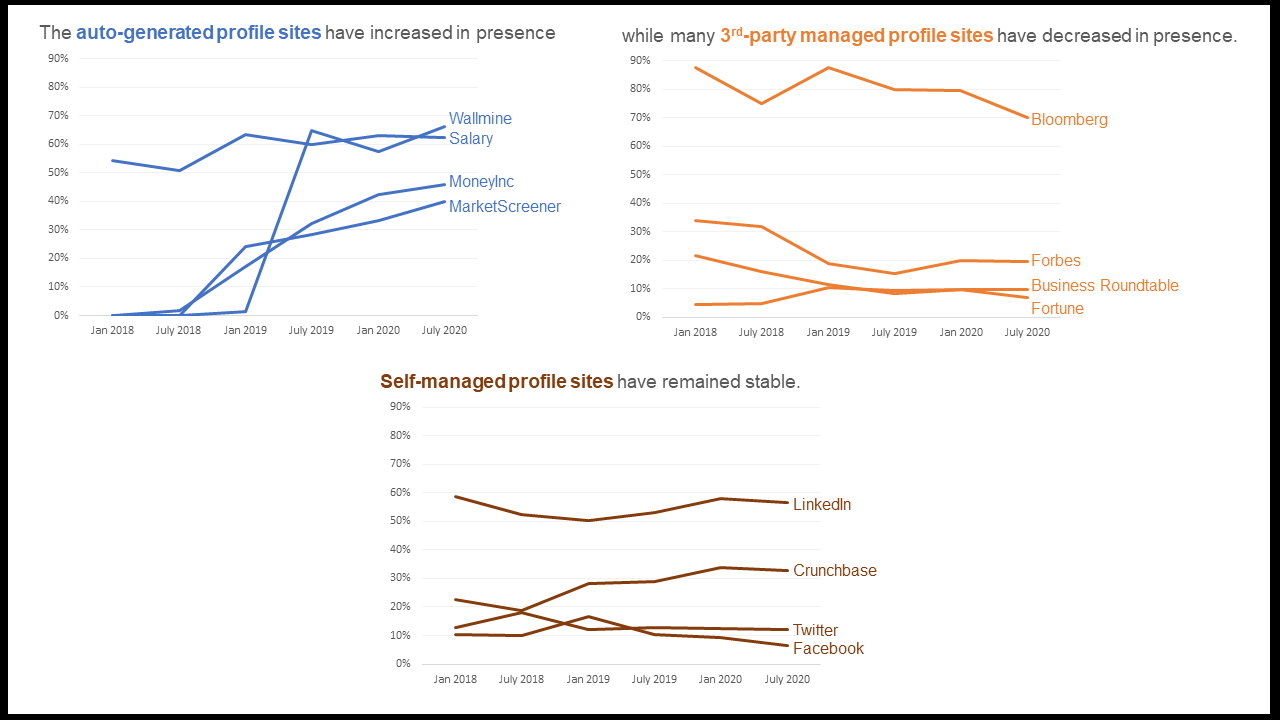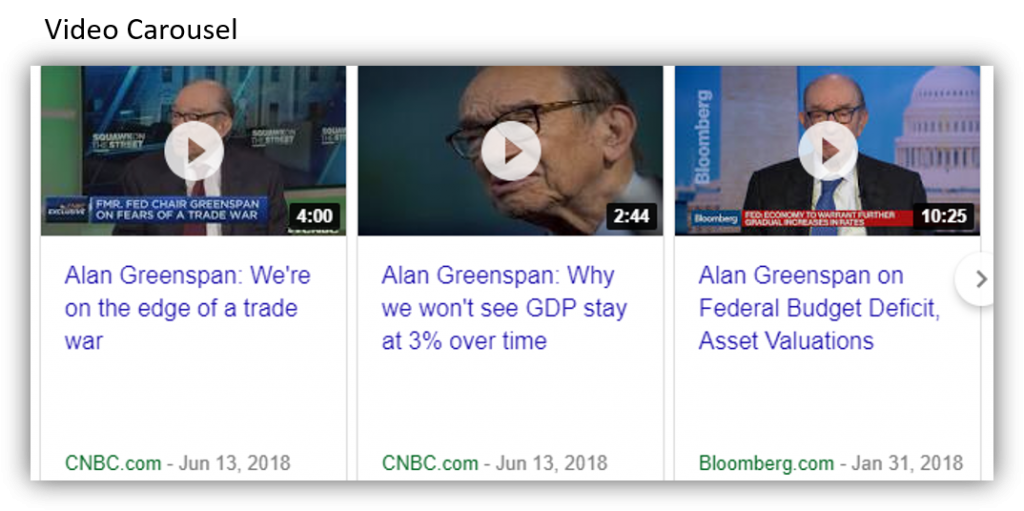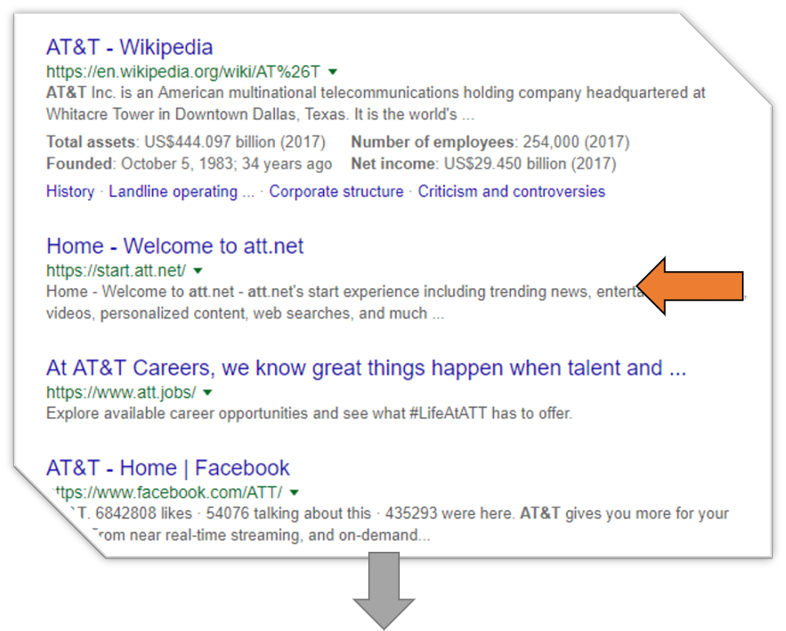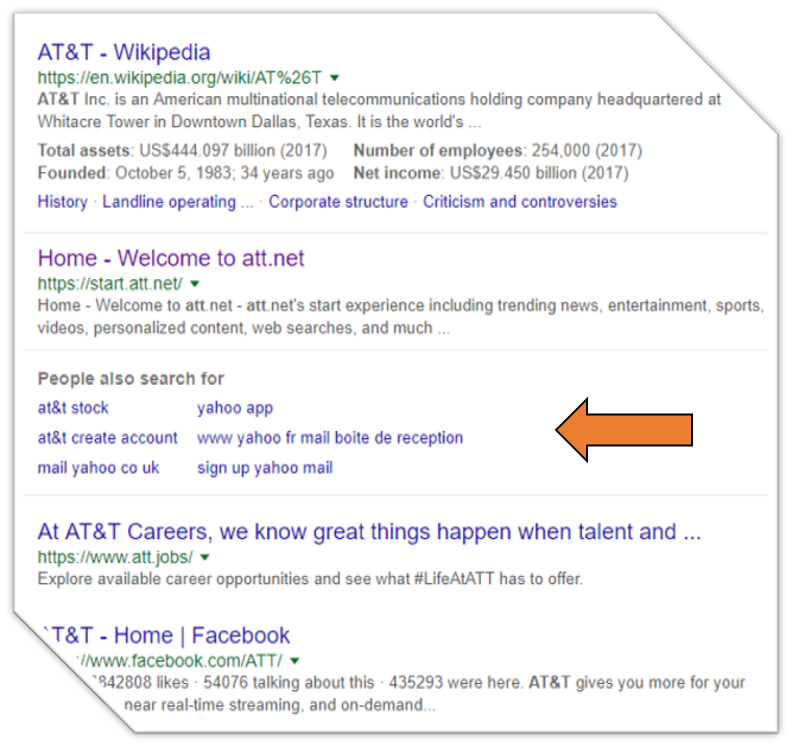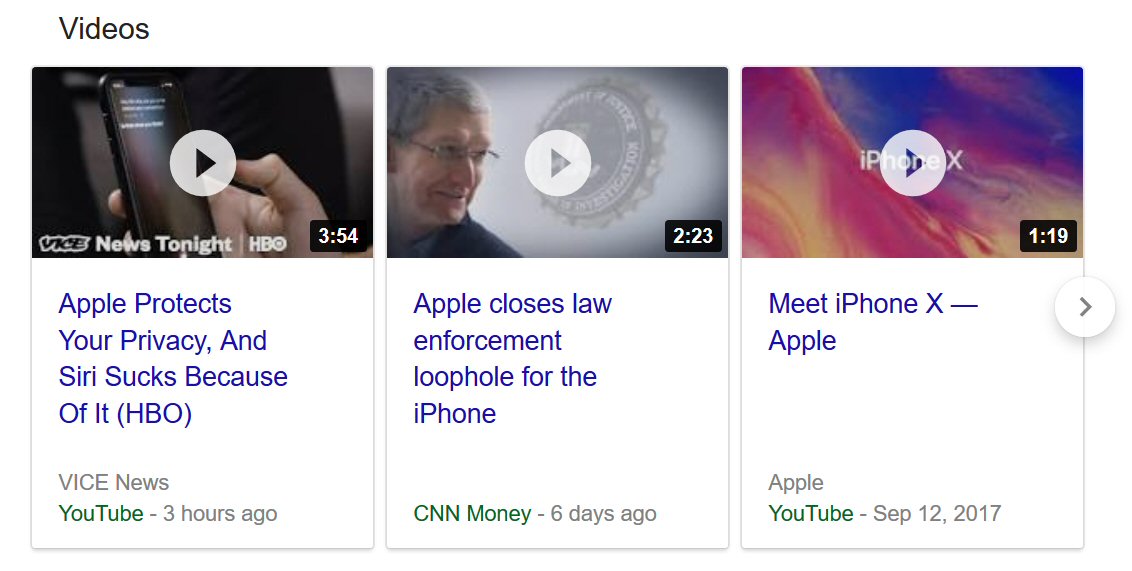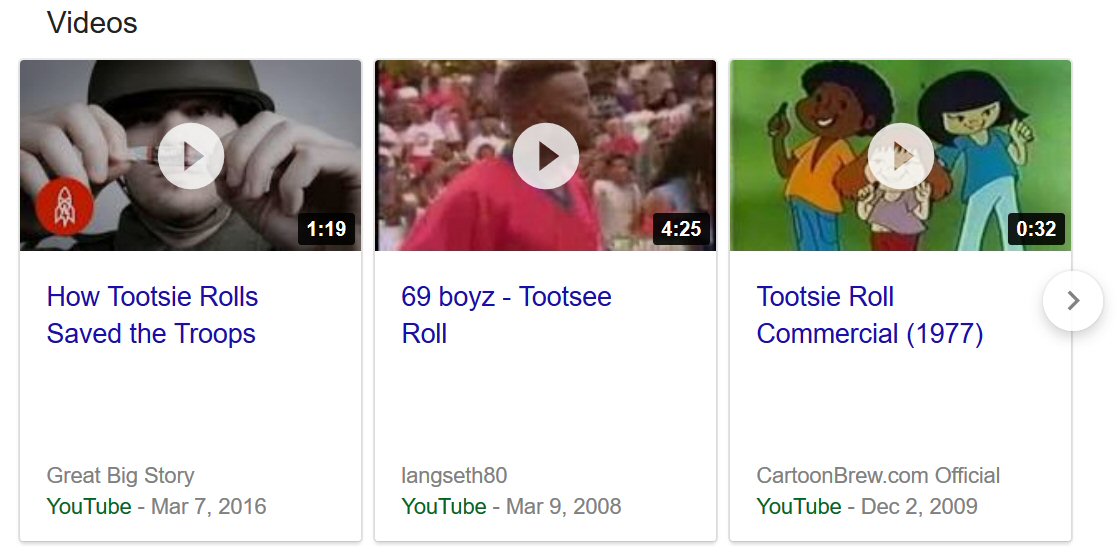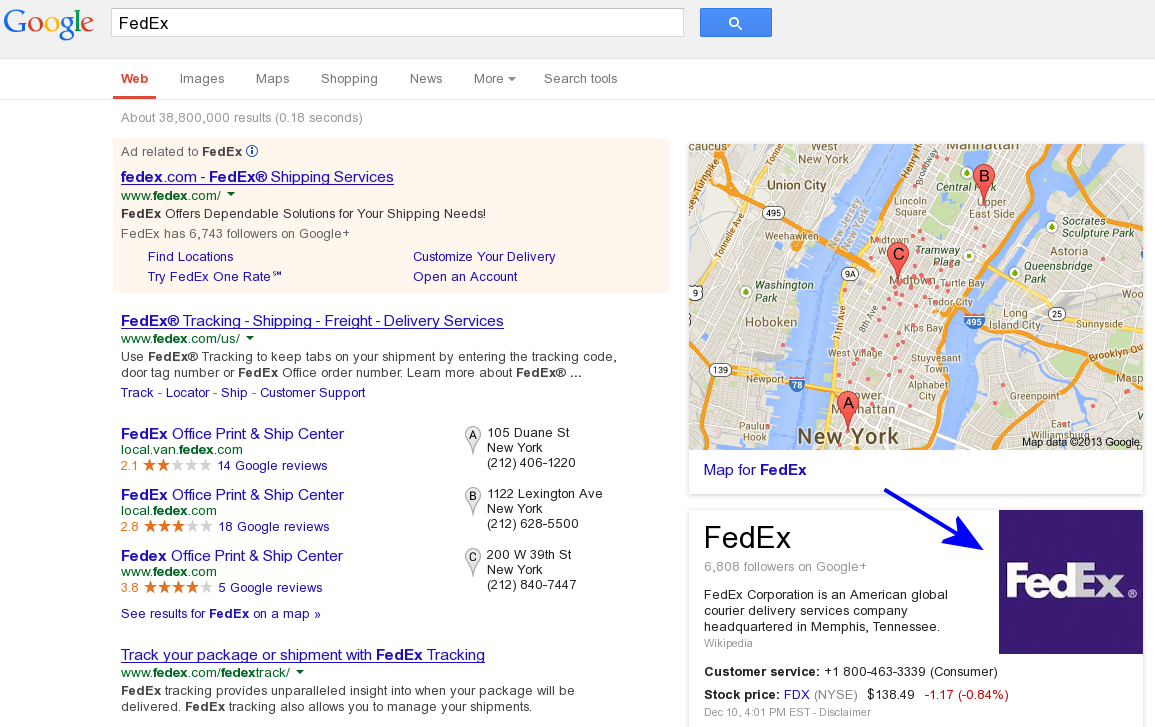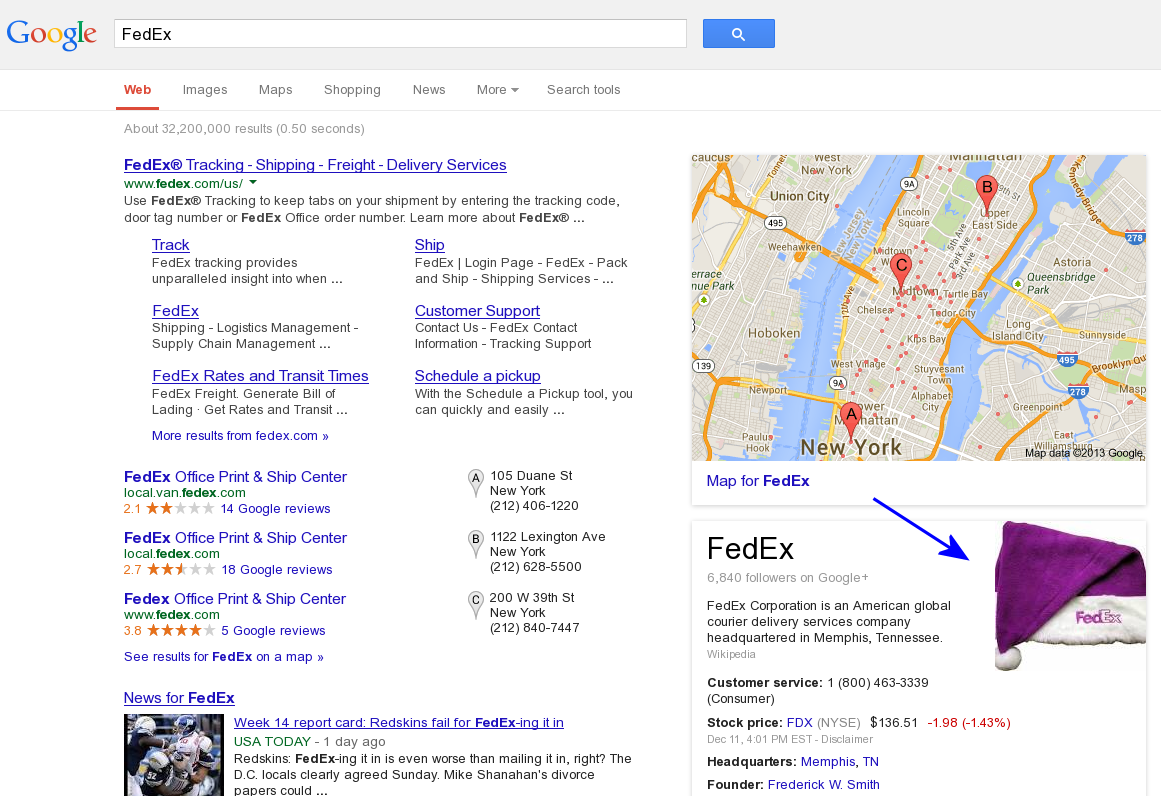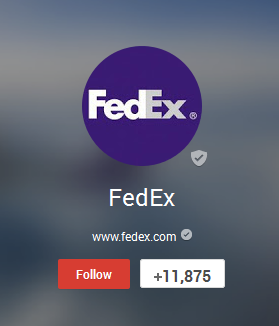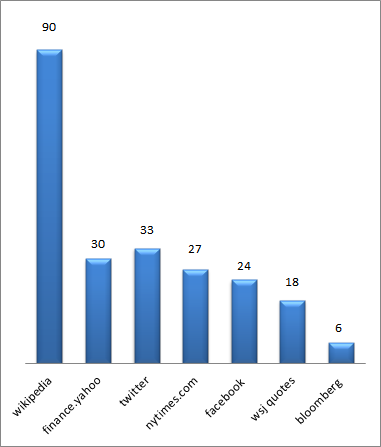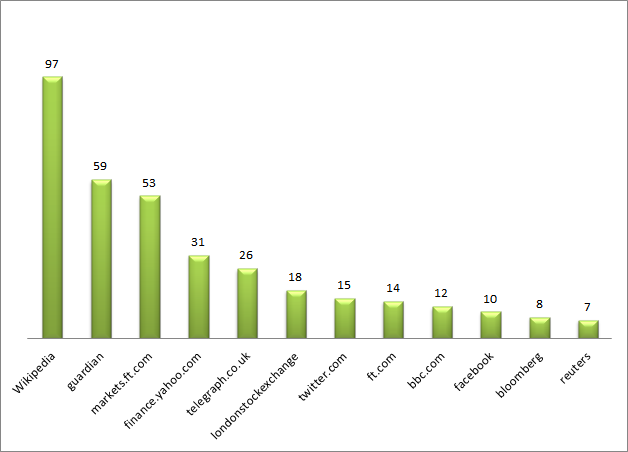Can you edit your or your company’s Wikipedia page?
LAST UPDATED – September 2024
Wikipedia Editing for Companies: Best Practices and Considerations
One of the most common questions we get regarding Wikipedia is whether a company can edit its own page.
The short answer is – it’s complicated, and there are important guidelines to follow.
Wikipedia’s Stance on COI – Conflict of Interest
Wikipedia’s purpose is to provide an encyclopedia of impartial knowledge. Content that is promotional, self-serving, or biased will often get flagged or removed by other editors.
Wikipedia’s official policy states:
“You are discouraged from writing articles about yourself or organizations (including their campaigns, clients, products and services) in which you hold a vested interest.”
In essence, editing the Wikipedia page about your own company is discouraged, as Wikipedia aims to ensure its content remains unbiased.
The Risks of Undisclosed Editing
It’s crucial to understand that:
- Wikipedia editors frown upon and may penalize pages that appear to have been edited by the company without transparency.
- Your IP address is recorded and visible to others. Never attempt to edit anonymously using a company-owned IP address.
- The Wikipedia editor community actively tracks changes. Your edits can trigger alerts for engaged editors, who may swiftly revert or challenge your modifications.
Free Consultation regarding your brand’s Wikipedia challenge: Contact Us
The Gold Standard: Disclosed Conflict of Interest (COI) Editing
Over the past few years, a new approach to Wikipedia editing has emerged, known as “disclosed conflict of interest” editing. This method is now considered the best practice for companies seeking to improve their Wikipedia presence. Here’s how it works:
- The company or individual creates a Wikipedia user account.
- They disclose their connection to the subject of the article on their user page or the article’s talk page.
- Instead of directly editing the article, they suggest changes on the talk page, providing reliable sources to support their proposals.
- Independent Wikipedia editors review these suggestions and implement them if they meet Wikipedia’s guidelines.
This approach aligns with Wikipedia’s values of transparency and allows companies to advocate for fair representation while respecting the platform’s rules.
Why Choose Disclosed COI Editing?
- It’s compliant with Wikipedia guidelines, avoiding the risks associated with undisclosed editing.
- It allows for more aggressive advocacy on behalf of your brand, as you’ve already informed the community of your connection.
- It typically leads to better long-term outcomes and a more stable Wikipedia presence.
How We Can Help
At Five Blocks, we specialize in navigating Wikipedia’s complex landscape for our clients. Our services include:
- Notability Analysis: Determining whether an entity has the required coverage for Wikipedia editors to accept and publish a new article.
- Current Page Analysis: Reviewing challenges and opportunities with existing content and sources.
- Content Planning and Drafting: Preparing content and sourcing for potential Wikipedia inclusion.
- Community Engagement: Working with the Wikipedia editor community to review and submit proposed changes via the appropriate talk pages.
- Vandalism Monitoring: Utilizing tools to monitor Wiki pages so that swift action can be taken when needed.
- Foreign Language Pages: Assisting in creating Wikipedia pages in other languages, following the specific guidelines for each.
Free Consultation regarding your brand’s Wikipedia challenge: Contact Us
Important Considerations
- Wikipedia’s editing guidelines are far more intricate than they may appear. The sources, writing style, and editor interaction require significant experience to manage effectively.
- Timing is crucial. Introducing a Wikipedia page in advance of a potential crisis may be beneficial, while doing so during a crisis could backfire.
- Building a positive Wikipedia presence takes time and patience. It’s a long-term strategy that requires consistent effort and adherence to Wikipedia’s principles.
Ready to Improve Your Wikipedia Presence?
If you’re looking to create or improve your company’s Wikipedia page, we offer free consultations to discuss your options and determine the best approach for your specific situation. Our team of experts can guide you through the process of disclosed COI editing, ensuring compliance with Wikipedia’s guidelines while working towards your goals.
Free Consultation regarding your brand’s Wikipedia challenge: Contact Us
Still have questions? See our FAQ
How do I edit an error on my company’s Wikipedia page?
While anyone can edit Wikipedia, it’s best to use the disclosed COI approach.
Best is to work with an experienced firm to suggest changes on the article’s talk page, providing reliable sources to support your corrections.
How do you create a Wikipedia page?
Wikipedia has strict standards for notability, citations, and conflict of interest. We recommend consulting with professionals to navigate these requirements and increase the chances of your page being accepted and maintained.
Can you edit your own Wikipedia page?
Direct editing is discouraged. Instead, work with an experienced team to ensure you are utilizing the disclosed COI method to suggest changes on the talk page and let independent editors implement them.
Who can edit a Wikipedia page?
Anyone can edit most Wikipedia pages, but it’s important to follow the platform’s guidelines, especially regarding conflict of interest.
Can I see who edited a Wikipedia page?
Yes, go to the ‘View History’ tab at the top right of the Wikipedia page. The username of the editor appears next to each change, along with the date.
Remember, working with Wikipedia requires patience, transparency, and adherence to the platform’s principles. By following these guidelines and best practices, you can work towards achieving a fair and accurate representation of your company on one of the world’s most visited websites.
Free Consultation regarding your brand’s Wikipedia challenge: Contact Us
Just the Facts: The rise of auto-generated profile sites, and what that means about the direction of search
People like to do quick, basic research before engaging in business. As the go-to place for that research, Google’s page 1 has become a kind of dossier about people and brands. This is why the Knowledge Panel (the summary info that typically appears on the top right part of the Google search results page) has become the gold standard for quick stats of notable individuals. It’s also why the People Also Ask box, with its quick and easy question and answer format, has been pushed front and center by Google. It’s as if searchers have repeatedly said to Google, “Just the facts, Ma’am,” and Google has complied.
Typically, results for top CEOs will include their Wikipedia page, their company’s website, top news stories, and various types of profile sites, which provide a quick snapshot of facts for users.
(Note: Perhaps the most interesting data point for many searchers is CEO salary: we found this in a previous study we did on the People Also Ask box. 22% of all questions appearing for Fortune 100 CEOs relate to their salaries.)
We recently surveyed Google results for Fortune 500 CEOs over three consecutive years (on the same dates) to assess the changing prominence of different kinds of profile sites in their top results.
We found that self-managed profile sites – LinkedIn, Twitter, and Facebook (in addition to Crunchbase, which can be self-managed) – have remained more or less stable in terms of their prevalence on page one for CEOs.
At the same time, third-party profile sites, like Bloomberg, Forbes, Fortune, and Business Roundtable have slightly decreased in page one presence for CEOs over the years. Bloomberg, for example, appeared in page 1 search results for nearly 90% of these CEOs through early 2019; today that’s down to 70%.
The sites that have risen in prominence are auto-generated profile sites, which pull relevant information from multiple websites and databases to create a one-page dossier on executives. These sites, namely Wallmine, Salary, MoneyInc, and MarketScreener, have significantly risen in prominence over the years. Wallmine in particular saw a meteoric rise in 2019 – from appearing for just 1% of CEOs to 65% of them within that same year.
What is interesting about this trend toward automatically created “scraper” sites is that they don’t seem to add a whole lot of value. What are they doing that Google cannot do by itself? Google’s algorithm already tends to prioritize pages and sites that help it answer popular questions and meet the common need for quick facts. Google does this by crawling much of the internet and then displaying the best pages and data points.
When companies do the same type of summarizing, this can be useful to visitors…but only for a time.
Some years ago we saw the same dynamic play out with Answers.com. In order to answer questions people often searched online, that site scraped various authoritative sources and created answer pages – which ranked prominently for tens of thousands of terms. Eventually, though, Google applied a more sophisticated duplicate content filter, demoted Answers.com, found other sites that added more original value, and added its own “dossier” features as discussed above. Answers.com simply wasn’t adding enough value to last long term.
So while right now there are several automatically generated profile websites appearing for many prominent individuals, some of which can actually be managed to some extent (MarketScreener offers an option for a paid profile, for example), we predict that these sites will not retain their prominence long- term.
In our estimation, for a site to remain relevant and prominent in Google search, it needs to add unique value, providing information or an experience that other sites do not…and that Google can’t manage on its own with its own knowledge graph data.
Ideally, sites that want to go the distance should be filling a gap – providing some deeper answers to the popular questions people have, adding images or videos where those are missing to flesh out someone’s persona, or providing information in a language that is not covered.
Google is a reflection of what people want to see, and people seem to want to see a quick and comprehensive picture. Staying valuable will require a heavier lift for content writers and researchers. The robots – the automated content aggregators – will need to find some other, more helpful, work to do.
About the author:
Miriam Hirschman., Research Manager at Five Blocks, is driven by an endless supply of curiosity and a deep background in data analysis as she digs for the interesting stories behind the numbers. Because we believe in data and tools but believe in people even more, she reviews massive volumes of search results, seeking patterns and finding order in the often chaotic world of web search.
When Google Must Not Get the Answer Wrong
You have probably noticed that Google has been steadily elevating the prominence of the “question and answer format” for some time.
Google first introduced the People also ask box in 2015. For a while, it was a low-profile feature, often appearing midway or lower down the first page. As with virtually all new features, Google did extensive testing to ensure they are useful to searchers.
By early 2017, the feature began rising in prominence, including appearing for 10-15% of Fortune 500 companies. In November 2018, the People also ask box started appearing for about 80% of companies and grew from there, today appearing for over 90% of the F500.
It appears that Google has figured out not only the kinds of questions people often ask, but that people appreciate the format as an efficient way to find information quickly.
This new format often presents questions we would have been unlikely to ask ourselves (a search for ‘gaming fingers’ brings up both ‘how do you play the game number fingers’ and ‘can playing video games cause trigger finger’), and returns answers with varying degrees of authority, simply because they seem to match well.
That is…unless getting the right answer is a matter of life and death. Then Google interrupts its regularly scheduled algorithms to present results much differently, cutting straight to the most authoritative answer. Nothing brings this home more clearly than the way Google is handling the COVID-19 crisis.
What is going on? Let’s take a deeper look.
The Paths of Search
When you search online, Google does quick triage:
If there is one unequivocal answer – as in ‘Who is the Prime Minister of Canada’ – that answer will generally be delivered in the form of a Featured Snippet or Knowledge Panel. A question and answer box will appear below this, with related questions, answered by various sources.
If your query is something less clear, like “gaming fingers,” Google’s algorithm is not sure of your intent, so it will generally provide a variety of different results to help disambiguate what you are trying to find; you can pick a specific path or decide you know enough from what you’ve read on the search page.
The People also ask box captures frequent intentions – and Google figures that your intent is likely to be similar to one of them.
But what happens when there’s a lot riding on the answer?
When the answer is crucial, like in an impending weather emergency or a search related to suicide, Google overrides its own algorithm – and provides answers that have the greatest likelihood of keeping you safe.
A Tornado warning in the searcher’s area appears in red at the top of the page when they do a weather-related search. In the case of a suicide-related query, a toll-free hotline number appears in a large font at the top of the page, with the text ‘help is available.”
In these cases, even if Google is not sure what you are asking — and even if there are probably a variety of accurate answers to a question like ‘how to kill yourself’ — Google will err on the side of caution.
In these cases Google sacrifices variety, balance, considerations of the searcher’s own history, and any other elements of its algorithm for the most direct route to possibly saving a life.
The Coronavirus Connection
In our current moment, searches for coronavirus or COVID-19 bring up an expanded knowledge panel — almost a mini- site — featuring symptoms, prevention, treatments, and statistics. The area is branded as a red ‘COVID-19 alert’, and all information is provided only by highly reputable sources.
The People also ask box is farther down the page than normal, and is referred to as “Common questions” instead; answers are sourced from highly authoritative sources – most prominently, the CDC.
Along with this new way of presenting coronavirus answers, Google has a new initiative to help medical organizations optimize their sites, so that their information appears prominently in Google searches, and populates the results for these types of medical questions.
SEO Roundtable has summarized the initiative here, in which Google has provided guidance for health organizations on:
- Mobile optimization
- The importance of good page content and titles
- How to analyze the top coronavirus related user queries
- How to add structured data for FAQ content
While it would obviously be easier for Google to simply give all worthy health organizations more weight in the algorithm (using some sort of ‘authority score’), it seems to prefer that these entities assert their expertise organically.
Even more “interventionist”: As of end March, Google began heavily prioritizing local COVID-19-related results, giving more prominence to local publishers as each country began developing unique approaches to fighting the virus.
Balancing Act
It seems that Google is scrupulous about accuracy only when there is a specific unequivocal answer, or when it thinks there might be a case of life and death. Maybe these are the only times Google won’t be called out for using influence in unfair ways?
Google’s opening gambit with health organizations, a half step between the democratic question and answer format and the tightly controlled emergency format, might be an interesting way forward in areas where more authoritative answers may not be immediately crucial, but would be appreciated by users – like nutrition or child-development.
In fact, all companies and professionals, following a best practices optimization strategy (titles, query analysis, FAQ content, etc.) can help establish their expertise on the results page. By assessing what questions people ask, and by answering them in the most relevant and easily understood way, companies may be able to make sure that the answers to the questions people ask are answered by their very own legitimate expertise.
It may not always be an emergency to get the answer right, but users would surely appreciate bumping into more true experts on their search paths.
How Deep is Google’s Love?: Where the In-Depth Articles have Gone (and What it Means for You)
Recently, Google appears to have made a significant change to its search results page that eliminated several in-depth articles for many clients. We’ve taken a deeper dive into this development to see what it could mean for brands and high-profile individuals, and the PR professionals who work with them.
As you know, when searching for a brand or an individual, the Google search results page presents a variety of relevant content pieces and types of media to satisfy the query. Often this means a company’s own webpage will appear at the top, followed by third-party content such as Wikipedia and news sources. There may also be social media results (if an individual or brand actively maintains these platforms), along with image results or video content.
Several years ago, Google introduced a section within top search results they called “in-depth articles”. These results looked very similar to other search results, but came from longform media outlets like Variety, Rolling Stone, or The New York Times Magazine. Often, they were a seminal article about the brand in question – articles that may have been placed by their PR teams.
Including these articles on the top results page seems to have been Google’s way of ensuring that a greater variety (and deeper) content would appear in this prime spot. Their inclusion, and the actual articles that appeared within that section, were governed by a different set of algorithms than most search results.
Recently, this section disappeared from all search pages for brands and executives. This happened without any announcement or acknowledgment on the part of Google. It is important to note that in-depth articles for many brands and individuals contained negative content. At the same time, it was the place where particularly engaging longform journalism made its way onto the prime real estate of Google page 1 for a brand.
The ramifications of Google’s elimination of this section are yet to be seen, and their motivation can only be assumed to be “less intervention” following high profile criticism of potential bias in their algorithms.
A whole host of interesting questions arise from Google’s move: What is the corporate (and civic) responsibility of those who hold the world’s data in their hands? Are there cases for intervention? Who decides what those are?
It is interesting to note that alongside this mysterious disappearance, a recent Five Blocks study of CEO search results found there are far fewer news sites (sites such as CNN, CNBC, and others) on the first couple of pages of searches for a CEO compared to a year ago. In addition, those pages feature many more profile sites, where one would find more dry facts (often created by the brand), and less news.
This marked difference in the presence of news within the organic results over the course of the past year, alongside the recent removal of the in-depth article section, means that page 1 of search for brands and individuals will contain far more“owned” content – i.e.: information they control.
For some brands this would appear to be a positive turn of events, but for many this trend means they will not automatically have great media pieces (which they often earned by being genuinely great) appear prominently in searches. It means they will need to work harder to deliberately ensure that the best third-party media does in fact place highly within their profile. Savvy communications teams will find ways to enhance their brands’ online presence within these brave new parameters.
— Sam Michelson, with Sara K. Eisen
Learn about Digital Reputation During a Crisis at the 2019 PR News Crisis Management Summit in Miami Beach – Thursday, February 28th
When crisis strikes, a company’s digital reputation becomes stressed and vital to their health. Five Blocks President, Howard Opinsky, will offer his insights at the Summit on the impact that crises have on digital reputations and what brands and individuals can do to prepare to weather the storm. Our team of digital reputation experts will also be on-hand to discuss how you can take control of your internet search results and shape them to best reflect your real profile. Join us at the Summit on February 27-28 in Miami Beach and don’t miss Howard and fellow panelists as they recount some of the best handled B2B crises and best practices in crisis preparedness at two sessions on Thursday, February 28. Learn more about the PR News Crisis Management Summit here.
Digital Reputation Trends – 2018
Over the first half of 2018, we have seen the search engine results continue to evolve from being a doorway to information to being the destination itself. This is not only evident in the composition of the search engines, but also in how users perceive the results (per the 2018 Edelman Trust Barometer).
I have continued to see clear attempts by Google to satisfy users and answer their question without any extra steps, by introducing several interesting changes to the search page functionality:
Ownership of the information
In June 2018, Google rolled out verification of the knowledge panel to more entities and notable individuals. This ability to take over the knowledge panel signals that Google wants entities to participate in providing factual information so that the searchers are provided the summary of an entity without having to search elsewhere.

Videos Carousel on the page
One of the latest changes Google has brought to the results page, following closely on the heels of Bing, is a video carousel similar to the already existing image box. While this could, potentially, reduce traffic to YouTube, the ultimate goal of immediately satisfying users apparently preempts the potential loss of YouTube advertising revenues.
Improved Search Suggests
A very recent addition to the features on the search page is enhanced search suggest.
When users click on a result and later return back to the search engine results page, Google sees they are searching for additional information and now suggests ancillary search queries directly below the original result. This feature precludes the need to do additional searches to find what the user may be looking for.
Continuous Scrolling
On mobile, Google has introduced a significant change with Facebook style scrolling, essentially creating an endless page of information. Stay tuned as this might come to all search results pages – not just mobile.
Outlook
Our outlook calls for search engines to continue efforts to provide the exact information the user seeks, ideally within the search page itself. We expect to see search engines return more content previously contained deep within other websites. It will be interesting to see how websites balance their desire to be listed within Google and Bing, and their need to hold onto their own data. Searchers will continue to demand more of the engines – who will do their part to provide the best information they can.
Google is boosting video with new video carousels
Over the past few days, we have begun to see a new and powerful feature in Google search results.
Instead of showing video results as before, they are now presented in a video carousel. This means that searchers see three videos in a box, with the ability to scroll and see additional videos. (Note that Bing rolled out a similar feature weeks ago!)
The following carousel, for example, now appears in searches for “Apple”:
This is the one appearing for “tootsie rolls”:
These video boxes also impact how people see important topics like GMOs:
Interestingly, this new video box doesn’t just appear for topics where video is an obvious result; we are also seeing video carousels on page 1 for many of our clients. For example, we see it for Fortune 500 companies and their CEOs, hedge funds and their managers, hospitality brands, financial institutions, and high net worth individuals.
The videos in the carousel are sourced from sites like YouTube as well as the Wall Street Journal, CNBC, and Yahoo Finance. In many cases, the videos are being sourced from the brand’s official website as well.
Google has just given brands the equivalent of $1,000s in free video advertising – if they know how to leverage this new feature!
Some thoughts on what this means:
- With more clicks going to video than before, brands that weren’t previously harnessing the power of video will want to consider an appropriate strategy.
- Brands that have preferred video content should use best practices to ensure their preferred videos appear prominently. This is likely to require an ongoing effort, as the algorithm governing the choice of videos is new – not the one that determines the order in Google’s video search.
- This is a reminder to brands to ensure that their onsite video content is being properly crawled, cached, and indexed.
- The thumbnail image of a brand’s videos is now part of the first page of results. This means that it is time for brands to revisit these and to make them optimal for branding and to attract clicks.
There are still some kinks for Google to iron out. In a few cases, we saw the same video appear multiple times in the carousel, sourced from different sites. We also noted that Google hasn’t yet connected the video carousel’s content to related brands. (For example, for Target, which has an active YouTube channel, none of the six videos shown were related to the brand.)
Overall, we believe that this feature, harnessed optimally, can be valuable for brands seeking to expose visitors to engaging content. Our goal is to help brands tell their story online and video is often the best way to do just that.
If your brand or executives could benefit from having a better control of their online image, we are happy to discuss how we may be able to help.
It Pays to Be Wordy…And It’s Free!
Twitter jumped into the 2017 holiday season with something new for its 330 million users: the gift of more gab. As of early November, it officially doubled the character limit for a tweet, jumping from 140 to 280 characters.
Reactions so far are split on whether this is a good thing, with some already mourning the loss of creativity forced by the 140-character constraint. However, there is a major hidden benefit to Twitter’s new world of wordy: the way it affects your search results page.
Since August 2015, when someone Googles a term associated with a Twitter account, the search results have included a dedicated space for actual tweets from that account. That’s a win for companies, brands, and people who care about their online presence. It means their voice is right there on the search results page, in a section whose contents they completely control.

With Twitter’s newly doubled character count, we wondered if Google would come along for the ride. Would the Twitter box on the search page double in size? Or would it just cut off the tweet after 140 characters?
The answer? For Twitter boxes featuring the wordier 280-character tweets, the actual box has grown to accommodate the greater length.
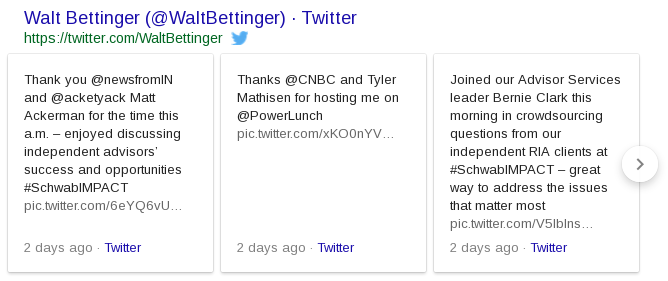
This is an incredible branding gift from Twitter and Google, offering even more space in the search results for a brand (or company, or individual) to control and to tell their own story. This is the kind of space brands pay money to have on the search page.
Brands should welcome this gift with open keyboards. They have learned how to be creative in 140 characters; now it’s time to embrace the new challenge to be engaging, yet still pithy, in 280.
What’s more, companies can reap the benefits of a longer Twitter box on the search page without being needlessly wordy all the time. The box works as a carousel, allowing the searcher to scroll horizontally through a few recent tweets, beyond just the first three showing. We discovered that if any of the tweets in the box – even the ones not initially visible – are longer, it lengthens the whole box.
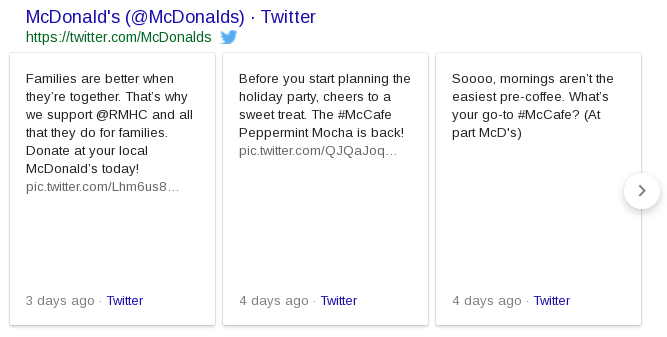
In this new era of Twitter 280, brands have the opportunity to offer deeper thoughts, or even just thoughts that are longer winded. That’s their choice. But now it pays to be wordy – without even having to pay.
Why did Google tell you to look up Kenneth Frazier’s Wife?
Kenneth Frazier is in the news for quitting Trump’s Business Council – and that has led to millions of searches on Google. This happens every time an executive is in the news.
At Five Blocks we help brands and executives manage their online reputation.
We pay especially close attention to Google’s “Search Suggest” – the autocompletes – like the one for Ken Frazier’s wife..
Google suggests the phrases that are most likely to resonate with searchers – based on past experience.
In this way, Google Search Suggestions are a window into what people think about you and/or your brand.
Kenneth Frazier, The CEO of Merck, isn’t alone in a recent study we conducted, over 40% of Fortune 100 CEOs’ names are associated with family-related terms in Google Search Suggest.
Meaning when searchers type in the name of the CEO, they see something like ‘family,’ ‘wife,’ or ‘son’ as one of the auto-completes suggested by Google.
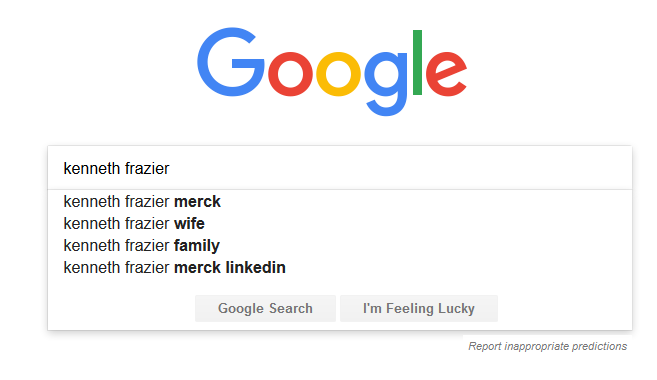
This suggests that when searching CEOs many stakeholders want to know more about them and their families.
With our Fortune 500 clients we will often recommend monitoring each of the suggested quires and ensuring that the brand manages content will satisfy the searchers while making sure to respect the individual’s privacy.
It also may be interesting for companies to analyze the timing associated with the appearance of these search suggestions. Do searchers look at a CEO’s family at a time when they feel confident about the CEO? Is it in crisis? It’s even possible that the appearance of these and other suggestions may be associated with changes in sentiment toward the individual by company and are therefore related to rises or falls in share prices.
If your brand or key executives may need assistance managing your digital reputation – please contact us at services @ FiveBlocks.com.
How to Change Your Logo in Google Knowledge Graph
Many of our clients are B2B and B2C brands. Their ability to control how their logo appears in Google search results is really important to them. Google has helped these, and other, brands by including their logo as a central element in the Google Knowledge Graph. The ability to dictate exactly which version of the logo is used can be crucial to having the best impact on searchers.
This is how you do it:
- Use your preferred logo as the logo for your brand’s official Google+ profile (use verified name and link to your main website).
- If there is a Wikipedia page for your brand, make sure the logo image is your preferred version.
- Use Schema.org’s organization markup to indicate to Google the preferred logo. Google has said they will honor that (presumably in the absence of a Google+ logo).
FedEx and Fun with Knowledge Graph Logos
Fedex decided to change their logo to a holiday logo version. On or before Dec 11th, they changed the FedEx logo on their Google+ page to the holiday version.
Shortly thereafter, their knowledge graph logo changed as well.
Before:
After:
Meanwhile – FedEx has changed their logo in Google+ back to the standard logo:
But the Google knowledge graph still has the holiday logo on it.
In SEO, they often say “If you don’t like your results, wait five minutes.”
In this case, I would recommend that FedEx also uses Schema.org’s organization markup on their homepage to indicate to Google the preferred logo.
They can also go back into Google+ and change the logo to a new file in the hopes that Google will detect the change and update the knowledge graph image.
Digital Reputation Management: It’s Not All About Burying Results

I posted the following on Business Insider in response to a post that focused on the underbelly of the Digital Reputation Management industry.
Many companies and individuals who have online reputation issues are not trying to bury negative reviews or articles. Instead, they are working to make sure that people searching for them online find what they are looking for. This need often arises when the brand or individual has not made any effort to create an online presence (think either a minimal website or none at all, no participation in social media, no business profiles, no YouTube channel, etc.)
Take for example a financial services firm which mostly arranges M&A’s. An article on a popular business news website portrays a potential upcoming deal for the company in a negative light – probably due to the author’s view of the industry in which the company is involved. The financial services company isn’t active online. They have a one-page website that does not appear prominently in searches online. Most of the prominent mentions of the firm seen in a Google search contain contact information, SEC documents and occasional mentions on investor portals.
The goal of an online or digital reputation management program for this client (and many like it) is to help the client present their brand appropriately online. There really is no need to subvert any search engine algorithm or bury any results.
The Digital Reputation Management program would consist of elements such as:
- Building out the current website so that it is technically sounds and contains content that will help it rank well in search engines.
- Creating company and individual profiles on sites like: LinkedIn, CrunchBase, and others.
- Working with Wikipedia editors to correct any incorrect information appearing in Wikipedia – including providing sources to editors that they can quote.
- Registering the brand and key individuals on social media websites that may be appropriate to use in the future (Twitter, Google+, etc.).
- Working with the client’s communications team (or their external PR firm) on opportunities for publishing thought leadership materials in one or more relevant media outlets.
In short, there are many tools at the disposal of digital band management professionals that, rather than being exercises in removing negativity, are proper digital branding and communication efforts. Rather than focusing on fooling the algorithm (in the long term Google will beat you!), serious companies should be considering digital reputation management strategies and tactics that take advantage of Google’s algorithm and its ability to detect relevant, authoritative content from a variety of sources.
Brand Reputation for the FTSE 100 vs. the Fortune 100
Before we can start work aligning a brand’s online reputation to match their corporate objectives, we need to understand something about the playing field.
We need to understand what types of results are typical for brands in the same market. Many of our clients are Fortune 100 and Fortune 500 companies, so we have done extensive research into this market.
Below is a table depicting the frequency with which we find various sites as top ten results in Google’s natural search results. (Data is from Nov 9, 2012).
The number above each bar represents the number of company search results in which each website appears.
As you can see from this chart, the most prevalent result for companies in the Fortune 100 is Wikipedia – appearing in 90% of page one results for Fortune 100 companies.
It’s interesting to note that Facebook and Twitter are each appearing in F100 first page Google results about 25% of the time.
Also interesting is that Yahoo Finance continues to be an important finance site as compared to Google Finance – which does not show up in the top ten.
A takeaway for companies in the space would be to look at the frequently occurring websites and determine if your brand should also have similar results. Knowing that Google tends to “like” showing a specific type of result seems to make it low-hanging fruit – an easy win if it’s something that will help your online reputation.
What about the FTSE 100?
In preparation for a week of meetings in London, we decided to compare the same type of data as seen in Google.co.uk results for the FTSE 100.
In the UK, Wikipedia is even more prevalent. Only 3 FTSE 100 companies have no Wikipedia page appearing in their Google page 1 results! Also noteworthy is the strength of The Guardian as a result shown in the first page Google results for 59% of all FTSE 100 companies! (Note to PR department – The Guardian is more likely to impact online reputation than the BBC, The Telegraph and Reuters combined!). In the UK Markets.ft.com outranks Yahoo Finance in prevalence by a significant margin, with Yahoo Finance still maintaining a significant foothold.
On the social media front, Twitter and Facebook are less than half as likely to be in the Google first page search results for a FTSE 100 company – as compared to a Fortune 100 company.
Notable as well is that neither group has video results coming up with any frequency. Image results show up in 6 of the FTSE 100 search results, but in only 2 of the Fortune 100 first page results.
With this knowledge, we are better prepared to look at FTSE 100 companies – and indeed at company results for other companies in the UK with a better understanding of which sites play significant roles in online reputation. When we approach a client program, we then take the additional step of doing a more exact comparison of the peer group – the companies or individuals that are most similar to the client. This offers further insight as to the way in which Google treats those keywords within the local search market.

